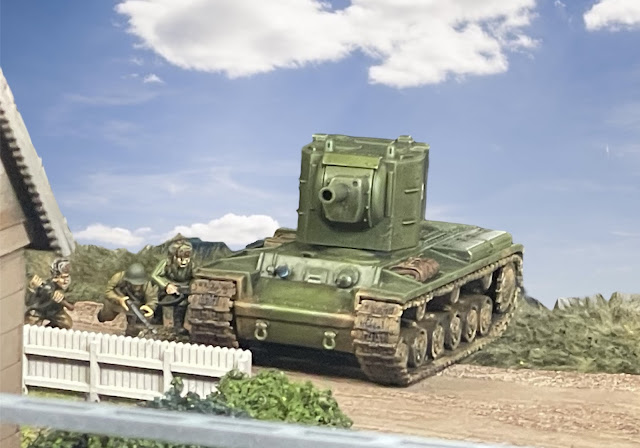The Soviet counterattack continued to press the Axis defenders after landing on the far bank as dawn broke (see here.) All across the front a foothold had been gained. Soviet squads climbed out of boats while more rushed onto the two bridges spanning the river. The German and Hungarian defenders had reacted slowly due to a Soviet God of War bombardment that kept heads down and delayed reinforcements. The Axis forces initially blunted the attack with fierce defending, and high officer casualties especially among the Russians had impeded the attack. The overwhelming numbers of Soviets were beginning to be a problem especially on the Hungarian flank where the heaviest attack struck.
 |
| Crossing the large bridge. |
The Hungarians were having problems defending a not very defensible position. They were outnumbered, their Toldi support tank had been sent up in flames, their Cbasa armored car was ineffectual, and only with help from a German Panzer 3 were they able to hold on. That was not to continue.
The T-26 shelled the armored car, first wounding its commander and then bailing the crew. The T-26 had advanced a bit farther than it should and the Panzer 3 rolled over a fence and caught the side armor of the smaller tank. The order to fire was given and the Panzer struck the turret of the little Russian tank, wounding the leader and disorienting the crew. The Panzer fired again, temporarily disabling the T-26.
 |
| This is ridiculously close stuff |
In order to save their tanker comrades, a Soviet infantry squad rushed from the bridge behind the T-26 and straight at the Panzer 3 while readying satchel charges and Molotov cocktails. A Hungarian squad reacted to protect the tank and a hand to hand fight exploded around the tank. The Soviets overwhelmed the depleted Hungarian squad and annihilated them, forcing the only surviving Hungarian Senior commander to flee. Two more Soviet squads crossed the wheat field from the opposite side of the yard and poured fire into the other Hungarian squad.
 |
| The trap is closing |
The brave Hungarians had bought the tank time which the Panzer used to step on the gas and lurch past the T-26 and away from the swarming Soviets.
With the Panzer gone, the remaining Hungarians were doomed. Two light marchine guns, a Maxim machine gun, and several riflemen pinned the Hungarians into place while another squad swung around the flank and poured murderous fire at the out in the open defenders. The Huns were wiped out.
A single German squad that was attempting to extract itself from this mess pulled back and tried to join the tank in a retreat towards the built up area where it could try to regroup.
 |
| The Germans used their Hungarian shields well.. |
The Axis right flank was good and well caved in. They had no effective defense on the right and the Soviet steamroller was moving by a brilliant tactical maneuver.
On the Soviet right, things were more difficult. Unlike on the Axis right, the Axis left was very defensible. Two Soviet infantry squads and another Maxim machine gun team were caught in murderous crossfire that routed one squad and pinned the other. The Maxim team was also pinned.
Two more Soviet squads rushed the large bridge and sustained heavy fire from two German infantry squads. Casualties were horrific.
The Russians managed to reach the far end of the bridge where a very brave engineer squad cleared the barbwire entanglement under heavy fire.
 |
| It’s not so good to have a bunch of red tokens by your troops…those are shock. |
The effort by the brave wire cutters, alas, seemed to be in vain. Heavy fire from multiple Mg34s, riflemen and German machine pistols raked the attackers.
Oh yeah, the ever present KV-2 showed up again.
This beast was persistent. Despite odds being against it showing up even once in three battles, it rolled onto the battlefield in all three. It narrowly survived an 88 shell in the previous fight, and here it was again lobbing shells from across the bridge into the German infantry.
 |
| A newly finished paint job deserves two pictures. |
The Soviet tanks were pretty but infantry wins battles. On the German right it was sorely lacking.
Game Note: At this critical point the Germans were taking a pounding in Force Morale which had dropped from 20 to 15. The Soviets had dropped from a start of 35 to 26, which is where they stood at the start of the evening and then to 18 by the end of the evening. Heading into the final push it would be close.
The end of the third fight of the Barbarossa campaign was closing in. The Soviets dominated the more open rural part of the riverbank but were struggling in the more built up area as expected. It all came down to morale. The Soviets had taken a bigger hit but the Axis had less to lose. Could the Soviets exploit their numerical advantage or could the Germans make it too costly to push into the city?














No comments:
Post a Comment